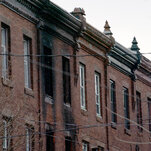
18 Relatives in a Deadly Fire: For Some, Crowded Housing Is Not a Choice

A fire that raged through a public housing unit in Philadelphia left 12 people dead. But families living in cramped conditions have few options, with thousands waiting for subsidized housing.

PHILADELPHIA — The main thing people noticed about the century-old brick house at 869 N. 23rd St. was all the children, who would spill out noisily every morning into the streets of Fairmount, a comfortable neighborhood just north of the heart of the city.
But after a fire roared through the upstairs apartment on Wednesday morning, the hidden reality of the house was laid bare to the world. Firefighters found that 18 people had been inside the four-bedroom public housing unit, triple the number of people who had moved in a decade earlier. And now twelve of them — mothers, sons and daughters of one big, extended family — were dead.
“Rosalee believed that it wasn’t safe,” Caleb Jones, a child therapist who worked with two of the children, said of a mother who died in the fire.
With several people crowded into each bedroom, the family had wanted to move to a larger home for years, Mr. Jones said. But with 40,000 households already on the waiting list for public housing in Philadelphia, they had little choice.
“I know it’s a freak accident, a fire,” Mr. Jones said. “But them being in that situation was systemic.”
The situation — a growing family forced to crowd ever more tightly into the apartment it already had — is not unique to Philadelphia. Across the country, a crisis in affordable housing has been festering for years, and with the lifting of eviction moratoriums and the dwindling of rental assistance funds offered during the coronavirus pandemic, it is only getting worse.
Image
While Philadelphia’s housing costs are not nearly as high as those in cities like New York and San Francisco, a safe and affordable place to live is still out of reach for tens of thousands of the city’s residents. Nearly a quarter of its population is below the poverty line; among families headed by single mothers, like the victims in the recent fire, the number rises to 42 percent.
This has meant a desperate scramble for housing owned or subsidized by the Philadelphia Housing Authority, one of the largest housing authorities in the country, and one that has been steadily building back from a troubled past of corruption and mismanagement. The federally funded and regulated agency owns or supports housing for 80,000 people, though in one of the country’s poorest big cities, this is not nearly enough.
The waiting list for public housing has been closed since 2013, except for older people and those with disabilities. The list for Section 8 vouchers for federal rent subsidies has been closed for even longer. According to a 2016 assessment of housing needs in the city, Philadelphia is supplying less than 12 percent of the publicly supported housing needed for its low-income households.
“Incomes are really low and the housing stock is really, really, really limited,” said Dina Schlossberg, executive director of Regional Housing Legal Services in Pennsylvania. “What is the standard we accept as a norm in our society for people who don’t have a lot of money and need a place to live?”
In one sense, those living in the upstairs unit on 23rd Street had been fortunate: They had a place, in a nice neighborhood. The three-story rowhouse was one of the housing authority’s “scattered site” units, properties that it owns and manages but are not part of a traditional public housing complex. More than 4,000 families are living in scattered site properties owned by the Philadelphia Housing Authority, which owns more such sites than any other housing authority in the country.
With this kind of public housing, poorer families are able to live in neighborhoods they would otherwise never be able to afford, like Fairmount, a once working-class part of town that has experienced several waves of gentrification. The median sales price of a home there is about $400,000.
A challenge of these scattered sites, however, is upkeep. Houses in Philadelphia are on average nearly a century old, said Kevin C. Gillen, a senior research fellow at the Lindy Institute for Urban Innovation at Drexel University.
Image
By the housing authority’s own estimation, the cost of capital repairs on its properties exceeds $1 billion.
“This is older housing in need of substantial rehabilitation,” said John Kromer, who was the city’s director of housing from 1992 to 2001 and briefly served as the interim chief of the housing authority. “Without enough funding to support a program like that, I think it’s inevitable that problems will occur.”
With such a squeeze on available housing, it is not easy to move from one apartment to a larger one, even as a family’s needs change. Shakia Miller, who lives in a three-bedroom unit at the West Park Apartments, which are owned and managed by the housing authority, applied for a bigger place when she was pregnant with twin boys. They are now 9 years old, yet the family, which includes Ms. Miller’s three older children, is still living in the same apartment.
“Emotionally, it puts a toll on everyone,” Ms. Miller said. “I don’t have any space of my own, my children don’t have any space of their own. It’s awkward, it’s very awkward, no one has any peace of mind.”
She has followed up with the housing authority numerous times over the years, she said, only to be told that she was on the list. She was not holding out much hope.
“I’m not going to say I threw the whole towel in, but it’s halfway in there,” Ms. Miller said. “Because I just notice as time goes on that they really don’t care. They really don’t care.”
Still, there are almost no other options for a low-income family, and those who have managed to find subsidized apartments are extremely reluctant to let them go — even if that means becoming desperately cramped as their families grow.
“Households do everything they can to remain housed,” said Vincent Reina, a professor of city and regional planning at the University of Pennsylvania. “They make dire trade-offs: trading off on food, health care and other basic needs.”
When the family moved into the 23rd Street apartment in 2011, according to Kelvin A. Jeremiah, the chief executive of the housing authority, it had needed the bigger space — four bedrooms — that was offered.
There were six people on the lease at that time, a number that expanded, by the time of the latest lease, to 14. There were three sisters, Rosalee, Virginia and Quinsha, and a growing number of children, including the quiet Destiny, who was a basketball standout, and Quintien, a mischief-maker who seemed to charm everyone he met.
Image
Mr. Jones, the therapist, said the children were self-conscious about the house and would not let friends from school come beyond the steps outside. He and his colleagues had become worried about how crowded the apartment was getting, he said, and encouraged them to try to move. Not that there were many options.
“There should have been a lot more resources for the family,” he said.
The cause of the fire has not been determined, but at least initially, investigators appeared to be looking at the possibility that it began with a child playing with a lighter near a Christmas tree. They were also looking at why several of the property’s smoke detectors, which had passed an inspection last year, failed to work.
“There’ll be a post-mortem,” Mr. Jeremiah, the housing authority director, told reporters. This would be an opportunity, he said, to assess “whether or not we should have moved them.”
Nichole Tillman, a spokeswoman for the Philadelphia Housing Authority, said the family had not requested a larger unit since it moved into the one on 23rd Street. Mr. Jeremiah said the agency had received “no indication” that the family wanted to split up into smaller apartments.
“The question of the family size is one that perhaps, frankly, you guys don’t understand,” Mr. Jeremiah said to reporters. “I grew up similarly, in a unit with 16 people. It’s intergenerational. It’s a question, perhaps, that resonates particularly with Black and brown communities.”
Claudia D. Solari, a senior research associate in the Metropolitan Housing and Communities Policy Center at the Urban Institute, said that children who grow up in overcrowded homes have more health and behavior problems. Arguing that an overcrowded apartment is better than homelessness is like trying to decide the lesser of two evils, Ms. Solari said. “They are both evil.”
For the families that are in such a situation, there may not be much of a choice at all.
“When you rest your head at night,” there is comfort in “knowing that ‘I’m here, I have a roof over my head, I have all my children, they’re not in the system, they’re not spread out across different family members, they’re under one roof where I can see them and keep them safe to the best of my ability,’” said Nisheia Andrews, a school therapist, who also worked with Destiny and Quintien.
Ms. Andrews had an intimate understanding of that choice. As a young girl, she too lived in a Philadelphia rowhouse crowded with relatives.
When she was 9, she said, that house burned down after an electrical fire. Her brother and cousin were killed.
But that is not all she remembers of her childhood. “We were together, we had good times, we were well taken care of,” Ms. Andrews said. “It’s just what families do.”
Kitty Bennett contributed research.
Source: https://www.nytimes.com/2022/01/08/us/philadelphia-fire-housing.html

















